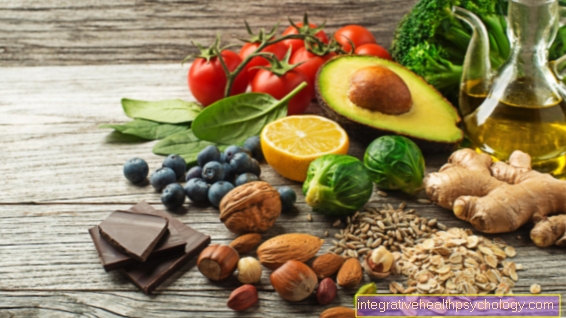Home remedies for a fever
introduction
Lowering fever with home remedies means nothing more than lowering the body temperature with natural aids. These can be used, for example, both from the inside in the form of food and from the outside in the form of cold leg compresses. What they all have in common is that they are usually available in every household or can be obtained over the counter if required. Due to their plant-based basis, most foods have few side effects compared to drugs and can hardly be dosed incorrectly. In the case of physical measures such as the cooling calf compresses, the side effect profile is larger in comparison, as they can lead to strong circulatory fluctuations in extreme cases.

Which home remedies lower a fever?
In principle, everyone has to find out for themselves which home remedies are best for lowering their fever. However, the principle of manipulating one's own body with measures against the fever should always apply as little as possible and as much as necessary. Simple measures such as clothing and bedclothes adapted to body temperature should therefore, for example, be given priority over cold application from outside using leg wraps. The higher the fever, the more the focus should be placed on good circulatory function. In more precise terms, this means ensuring that you have sufficient fluid intake and physical restraint. If the fever nevertheless leads to serious symptoms, a visit to the doctor should be preferred to using home remedies. However, home remedies can help lower the fever. Various teas with honey have proven to be positive, especially for colds with a fever, as they have anti-inflammatory ingredients. Onions have a good effect on otitis media as onion bags. Vegetable broth increases the supply of fluids in the case of flu-like infections. But ginger also has a decongestant and antipyretic effect. However, in addition to food, physical measures are also effective as home remedies. With every application of cold, however, one must be aware that the circuit can be exposed to a stressful situation due to the significant temperature difference.
Also read: How can you lower a fever?
onion
As a herbal remedy, the onion is a real all-rounder. If it is eaten, it supplies the body with vitamins, potassium and sulfur compounds and thus supports the body's defenses. If it is applied from the outside in the form of an onion bag on the ear, the sulfur compounds - so-called sulfides - have an anti-inflammatory effect. In the case of otitis media with a fever, this would mean that the onion applied externally does not lower the fever itself, but has an anti-inflammatory effect on the middle ear. However, as the inflammation recedes, so does the fever, so the measure indirectly lowers the temperature. If it is drunk in the form of an onion stock, it provides important vitamins and electrolytes that are needed to strengthen the immune system. Here, too, it does not lower the fever directly, but works indirectly by strengthening the immune system. Therefore, the onion can be used in a variety of ways. However, their impact should not be overestimated. It should only be used for mild complaints or as a support for other measures, as its healing power in an emergency is too low as a sole application. However, it can be quite suitable for alleviating the symptoms.
Vegetable broth
In the case of a fever, vegetable broth primarily relieves symptoms of accompanying complaints such as a sore throat. Drinking the warm broth has a beneficial effect on an inflamed throat area for many of those affected. This in turn has the effect that fluid intake is facilitated and thus the fluid requirement can be covered. The loss due to increased sweating, for example, is thus kept lower.Due to the enrichment with electrolytes and spices, it also has a pleasant taste for many, which stimulates the appetite. This has the advantage that the urgently needed energy supply does not come to a standstill in the event of illness.
Apple Cider Vinegar
The use of apple cider vinegar for fever is very questionable. The idea behind the application for a fever is that the vinegar has a cooling effect when rubbed on the skin. This is explained by the evaporation of the liquid on the surface of the skin. What many do not know, however, is that the evaporation of the liquid film leads to the skin drying out and does not have a lasting positive effect on temperature regulation. Rather, an excessive counter-regulation follows due to the short-term cold effect, which can lead to an undesirable subsequent overheating of the rubbed skin areas. In addition, sensitive skin types often react with itchy eczema to the application of apple cider vinegar on the skin.
Descending full bath
From a medical point of view, descending full baths is not advisable. Especially with a high fever, the person's circulation is very stressed, which is only increased by a full bath. The increased body temperature ensures that the vessels in the body are set wide. Figuratively speaking, the blood volume is distributed more in the periphery of the body, so that heat can be better dissipated via the extremities. In response to the redistribution, the heart beats faster. If a feverish person now lies down in a bathtub with cool water, the vessels in the periphery contract and the blood flows increasingly towards the heart. In people with or pre-existing heart disease, this can lead to life-threatening overloading of the heart. Therefore, “whole-body cooling” should only be reserved for special facilities in the hospital.
Also read our topic: Home remedies for a cold
honey
Honey can be used without hesitation in febrile illnesses. Its addition to teas is particularly popular for colds. Its anti-inflammatory effect is mainly due to the hydrogen peroxides it contains. They are able to weaken pathogens and thus promote the healing process. The high sugar content known from taste is also an energy source. From a medical point of view, however, it is rather negligible, since the amount absorbed as an additive to tea is too small.
ginger
Ginger is used today for many diseases. With regard to fever, it can be said that its anti-inflammatory effect weakens the pathogens that cause fever. If the pathogens are prevented from spreading, the infection does not increase and the body's defenses can fight the pathogens better. As the infection recedes, so does the fever. However, it should also be said about ginger that it only brings relief for mild symptoms. Prophylactically, however, it can be used very well for the onset of cold symptoms.
garlic
Garlic is very similar to onion in its effects and uses. However, unlike onions, garlic has its own antibiotic effect. Strictly speaking, it is the ingredient "allicin". Garlic works mainly from the inside through ingestion with food. By absorbing its components in the gastrointestinal tract, it supplies the body with important vitamins, electrolytes and sulfur compounds in addition to its antibiotic ingredients. A miracle cure can not be expected from garlic, because the concentration of the ingredients is very low. However, they can help to improve the fever.
Fever tea
Fever teas are usually available as ready-made tea blends in supermarkets or pharmacies. The herbal mixtures usually promise an antipyretic effect due to the ingredients of the willow bark. They can also be found, for example, in the well-known aspirin. It is the salicylates it contains that have anti-inflammatory effects and thus curb the infection. The healing process is promoted and the fever is reactively reduced. However, the concentration in teas is much lower, so that the effect is also weaker compared to a tablet from the pharmacy. However, it is to be assessed as positive that the tea, in addition to the fever-lowering effect, also helps to meet the increased fluid requirements.
Calf wrap
Leg wraps are a very good home remedy for lowering a fever. Their use should, however, be chosen carefully and the implementation should be constantly monitored by a relative. The principle of the calf wrap is to bring about a normalization of body temperature by applying cold externally to the legs. This means that warm incoming blood from the body is cooled down on the legs and then flows back towards the heart. Gradually, an exchange from warm to “cooled” blood should take place, thereby lowering the high body temperature, which is perceived as stressful. However, this method only works if the cooling is carried out gently. The temperature difference between the calf compresses and the body temperature should be chosen according to age. In adults, it is advisable to use lukewarm water for the calf compress, while in small children the water temperature should be around 3 ° C colder than body temperature. If the temperature difference is too great, the stress on the circulatory system is immense and in the worst case can lead to circulatory failure. However, if the temperature of the calf compress is gradually reduced from compress to compress, no serious incidents can usually be observed.
More on this: Calf wrap against fever
Home remedies for fever for children
In children, drinking enough fluids is the best home remedy for a fever. Thus, it is primarily the taste of the child that decides which drink should be offered more often if there is a fever. Teas with honey are particularly suitable because they are not too sugary. Lemonades and heavily sweetened juices should be avoided, as their high sugar content leads to additional dehydration in addition to the increased temperature. With the increased fluid intake, the circulation is stabilized and the self-healing of the body is supported. A balanced diet promotes this process. Due to their strong taste and smell, garlic and onions are usually not tolerated by children in the form of a brew, but they can certainly be used in a suitable form. If the fever rises sharply, calf compresses are a good way of reducing the fever non-medically for children of kindergarten and school age. Here, however, the winding process must be monitored and the temperature gradually reduced.
Further information: Fever in the toddler
Home remedies for fever for babies
In babies, one should be very careful with home remedies for fever. In general, a fever speaks for a functioning immune system and must therefore be viewed as a natural reaction. The increased body temperature exceeds the heat resistance of the pathogens and thus kills them. You should therefore only lower the fever if a baby is clearly suffering from symptoms. Noticeable sleepiness and laziness to drink are typical of severely impaired babies. If the fluid intake drops significantly, a doctor should be consulted immediately and the use of home remedies alone should be avoided. In mild cases, however, the use of herbal remedies should be avoided as babies are often very sensitive to the ingredients and allergic reactions can be triggered. It is best to use physical measures, but these should be done in moderation. It is best to choose appropriate clothing. At the peak of the fever curve, light clothing should be chosen and sweaty, damp clothing should be changed after a fever interval. This is the best measure and has the fewest side effects in addition to adequate fluid intake. Calf wraps should only be made after consulting a doctor. For example, they are not at all suitable for very small babies because the area for the heat dissipation on the calves is much too small.
More on this: What to do if my baby has a fever or Fever suppositories for children and babies





























